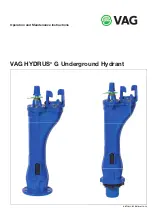
Ottobock | 13
3R46
The advantages of the 3R46 Knee Joint can only be made optimal use of in case of a correct
alignment.
The optimal residual limb position must be anticipated when positioning the socket connec-
tor.
Plumb lines in the frontal and sagittal planes (drawn from the hip joint’s centre of rotation and
marked during plaster cast taking and trial fitting of the test socket) will facilitate correct positio-
ning of the lamination anchor.
To align the prosthesis please proceed in two steps:
1) First make the bench alignment using an alignment tool such as 743L200 L.A.S.A.R. Assembly.
2) Then use 743L100 L.A.S.A.R. Posture for static alignment optimisation.
4.1.1 Bench alignment with alignment tool
(the following steps refer to Fig. 7)
Position the middle of the foot 30 mm anterior to the alignment reference line.
Add 5 mm to the required heel height of the foot. Set correct outward rotation of the foot.
Clamp the knee joint using the appropriate adapter inserts. For bench alignment, the alignment
reference line should run through the upper anterior axis (alignment reference point)
. At
that point the pyramid base should be horizontal. Pay attention to the knee ground distance
and outward rotation of the knee (adapter inserts provide for a rotation of approx. 5°). Recom-
mended positioning of the alignment reference point: 20 mm above the medial tibial plateau.
Connect the foot to the modular knee joint using a tube adapter.
Mark the centre of the socket proximally and distally on the lateral side. Draw a line through
both marks from socket brim to the distal end of the socket.
Now position the socket such that the alignment reference line passes through the proximal
centre mark of the socket. Set the socket flexion to somewhere between 3° and 5°; however,
the individual situation (e.g. hip joint contractures) must be taken into account and, if neces-
sary, more flexion should be provided. Also pay attention to the ischial tuberosity to ground
distance.
Attention!
If the residual limb flexion is not taken into account, the joint will be positioned too
far to the front. This will lead to malfunction and premature wear.
4.1.2 Static alignment optimization using L.A.S.A.R. posture 743L100
(the following steps refer to Fig. 8)
The bench alignment can be substantially improved using L.A.S.A.R. Posture. In order to ensure
appropriate stability combined with easy swing phase initiation, please proceed as follows:
To make the load line visible, the amputee stands on the L.A.S.A.R. Posture with the prosthetic
side on the force plate and with the other leg on the height compensation panel. The prosthesis
side should be sufficiently loaded (> 35 % of the body weight).
Now adapt the alignment by only adjusting the plantar flexion of the foot. The load line (laser
line) should be approx. 35 mm anterior to the upper front knee axis (see Fig. 8).
After step 2, dynamic optimisation can take place between parallel bars.
4.2 Combination possibilities
Depending on the patient's functional demands, the following prosthetic feet can be used:
Dynamic Motion (1D35), Trias (1C30), C-Walk (1C40), Axtion DP (1E58), Springlite II (1E61),
Advantage DP 2 (1E50/51) or Axtion (1E56). For the weight limit of prosthetic feet, please refer
to the Instructions for Use of the respective foot component.
Содержание 3R46
Страница 3: ...2 3 4 5 6...
Страница 98: ...98 Ottobock 3R46 2 2 MOBIS Ottobock 3 4 125 kg Otto Bock HealthCare 2 3 3 2 4 5 6 1 17 4 2 4 f f f f Ottobock...
Страница 103: ...Ottobock 103 3R46 4 5 Ottobock 5 5 1 5 2 CE 93 42 VII...
Страница 109: ...Ottobock 109 3R46 4 3 2 3 6 4 4 3R46 3R6 6R6 3S107TF 519L5 4 5 Ottobock...
Страница 115: ...Ottobock 115 3R46 4 3 2 3 6 4 4 3R46 3R6 6R6 3S107TF 519L5 4 5...
Страница 117: ...Ottobock 117 3R46 125 2 3 3 2 6 4 5 90 17 4 2 4 f f f f 300 3 3R46 3R46 110 740 99 90 30 82 17 125...
Страница 121: ...Ottobock 121 3R46 4 5 5 5 1 5 2 CE 93 42 EWG IX I VII...














































